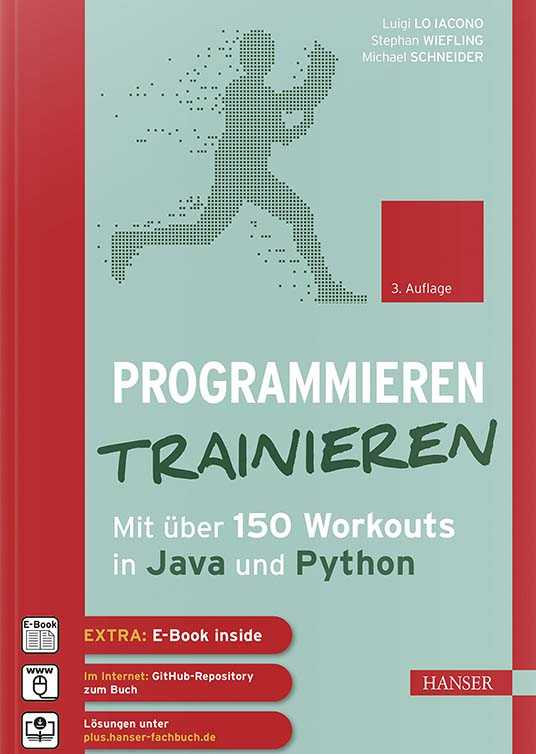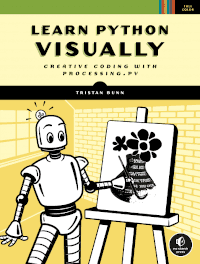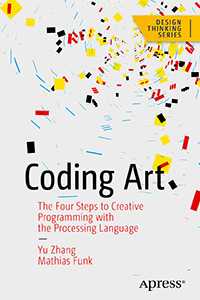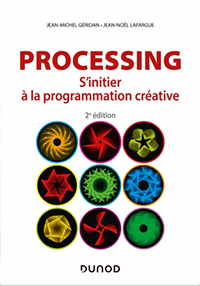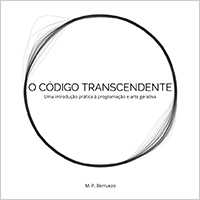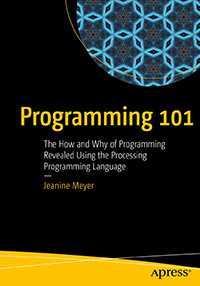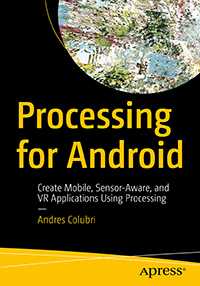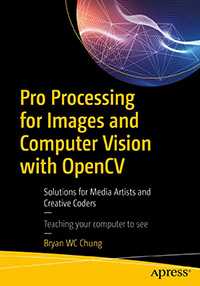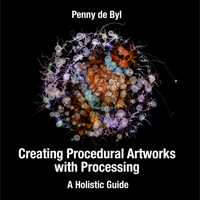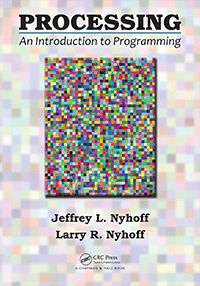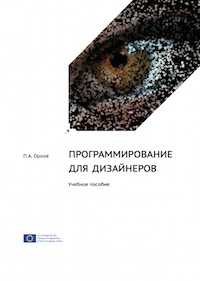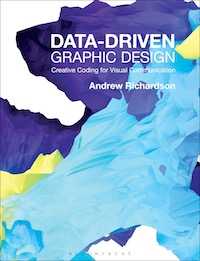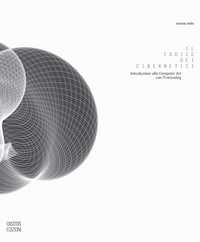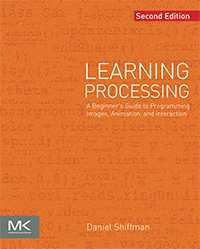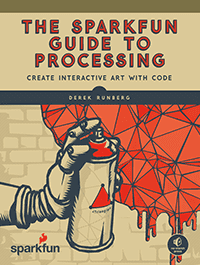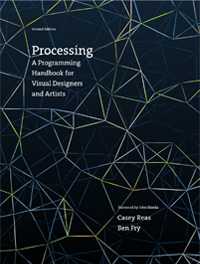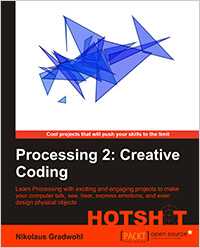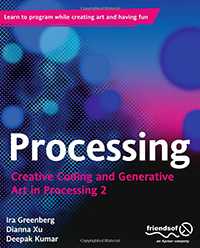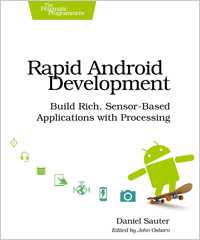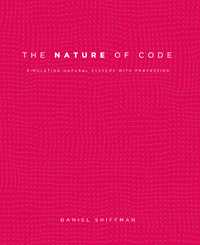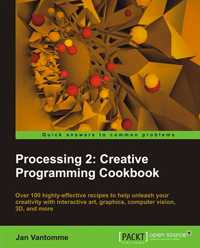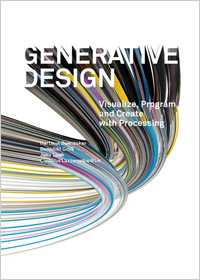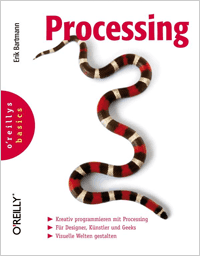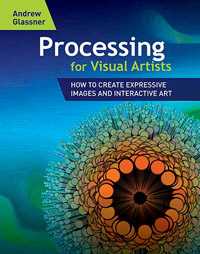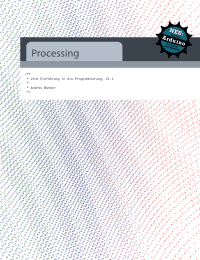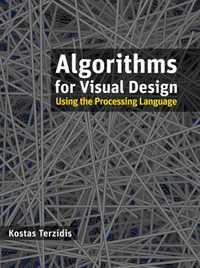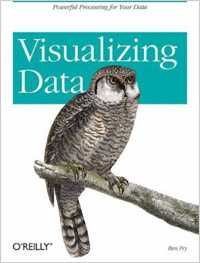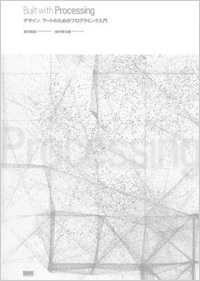Books
Processing books cover topics from programming basics to visualization. Browse this page to find the right books for you.
![Book cover for the book Programmieren trainieren (3rd Edition)]()
Programmieren trainieren (3rd Edition)
Published October 2023. Hanser Fachbuch, 308 pages, Paperback + E-Book Text in German
Read more
Der Programmier-Trainingsplan für alle, die weiter kommen wollen.
In diesem Übungsbuch trainierst du anhand von kurzweiligen und praxisnahen Aufgaben deine Programmierfähigkeiten. Jedes Kapitel beginnt mit einem kurzen Warmup zum behandelten Programmierkonzept; die Umsetzung übst du dann anhand von zahlreichen Workout-Aufgaben. Du startest mit einfachen Aufgaben und steigerst dich hin zu komplexeren Fragestellungen. Damit dir nicht langweilig wird, gibt es über 150 praxisnahe Übungen. So lernst du z. B. einen BMI-Rechner oder einen PIN-Generator zu programmieren oder wie du eine Zeitangabe mit einer analogen Uhr anzeigen kannst.
Solltest du mal nicht selbstständig vorankommen, dann werden dir in jedem Workout Lösungshinweise als Hilfestellung angeboten. Die kommentierten Lösungen liegen für Dich in den Programmiersprachen Java und Python in GitHub oder auf der Hanser-Plus-Seite zum Download bereit. Für ein möglichst ballastfreies Training wird für die elementaren Programmierkonzepte die Entwicklungsumgebung Processing eingesetzt. Für fortgeschrittenere Anwender wird auch der Einsatz von Eclipse und PyCharm gezeigt. Die Installation und Verwendung der Tools ist im Buch beschrieben.
![Book cover for the book Learn Python Visually: Creative Coding with Processing.py]()
Learn Python Visually: Creative Coding with Processing.py
Published April 2021. No Starch Press. 296 pages. Paperback and eBook.
Read more
An accessible, visual, and creative approach to learning core coding concepts using Processing's Python mode, Processing.py.
The publisher writes, "Right from the first chapter, you'll produce and manipulate colorful drawings, shapes and patterns as the author walks you through a series of easy-to-follow graphical coding projects that grow increasingly complex. You'll go from drawing with code to animating a bouncing DVD screensaver and practicing data-visualization techniques. Along the way, you'll encounter creative-yet-practical skill-building challenges that relate to everything from video games, cars, and coffee, to fine art, amoebas, and Pink Floyd. As you grow more fluent in both Python and programming in general, topics shift toward the mastery of algorithmic thinking, as you explore periodic motion, Lissajous curves, and using classes to create objects."
The publisher lists:
- Basic coding theories and concepts, like variables, data types, pixel coordinates, control flow and algorithms
- Writing code that produces drawings, patterns, animations, data visualizations, user interfaces, and simulations
- Using conditional statements, iteration, randomness, lists and dictionaries
- Defining functions, reducing repetition, and making your code more modular
- Writing classes and creating objects to structure code more efficiently
![Book cover for the book Coding Art: The Four Steps to Creative Programming with the Processing Language]()
Coding Art: The Four Steps to Creative Programming with the Processing Language
Published January 2021. Apress. 280 pages. Paperback.
Read more
The authors write, "Finally, a book on creative programming, written directly for artists and designers! Rather than following a computer science curriculum, this book is aimed at creatives who are working in the intersection of design, art, and education. In this book you'll learn to apply computation into the creative process by following a four-step process, and through this, land in the cross section of coding and art, with a focus on practical examples and relevant work structures. You'll follow a real-world use case of computation art and see how it relates back to the four key pillars, and addresses potential pitfalls and challenges in the creative process. All code examples are presented in a fully integrated Processing example library, making it easy for readers to get started."
![Book cover for the book Processing : S'initier à la programmation créative]()
Processing : S'initier à la programmation créative
Published August 2020. Dunod. 320 pages. Paperback. Text in French
Read more
The publisher says, "Processing est un langage à la fois simple, puissant et bien conçu. Pour ces raisons il constitue un excellent outil d’initiation à la programmation informatique et à la production artistique. Cet ouvrage d’initiation a été conçu à l’intention : • des créateurs qui produisent des installations interactives à l’aide de périphériques tels que la souris, le clavier ou la caméra, ou encore des cartes Arduino, des capteurs de distance, de mouvement, de température, de géolocalisation, etc. ; • des graphistes qui génèrent des images ou des motifs, des visuels ou des data visualisations programmées, fixes, animées ou interactives ; • et de tous ceux qui veulent s’initier à la programmation."
![Book cover for the book O Código Transcendente: Uma Introdução Prática à Programação e Arte Gerativa]()
O Código Transcendente: Uma Introdução Prática à Programação e Arte Gerativa
Published December 2019. 270 pages. PDF, Web. Text in Portuguese
Read more
Este livro é um guia de programação com enfoque prático considerando o contexto da arte gerativa e do pensamento computacional. Ele conta com explicações e exemplos visuais cuidadosamente projetados para serem de valor tanto para programadores quanto artistas. As aplicações e estudos de caso foram direcionados para a linguagem Processing cuja própria filosofia segue o princípio da exploração do artístico através do código.
![Book cover for the book Programming 101: The How and Why of Programming Revealed Using the Processing Programming Language]()
Programming 101: The How and Why of Programming Revealed Using the Processing Programming Language
Published June 2018. APress. Paperback, eBook.
Read more
The Publisher writes, "Understand the importance of programming, even if you’ve never programmed before! This book will teach you the basics of programming using the Processing programming language. You will create your own Processing sketches, using personal images, themes, or hobbies that you enjoy. The chapters in the book will demonstrate the process of programming, starting with formulating an idea, planning, building on past projects, and refining the work, similar to writing an essay or composing a song. This approach will guide you to make use of logic and mathematics to produce beautiful effects. The term for program in Processing is sketch, though the sketches featured in this book are far more than static drawings; they incorporate interaction, animation, video, audio, and accessing files on the local computer and on the Web. Technical features are introduced and explained in the context of complete examples: games (Snake, Hangman, jigsaw, slingshot), making a collage of family images and video clips, preparing directions for folding an origami model, rotating objects in 3D, and others."
![Book cover for the book Processing for Android: Create Mobile, Sensor-Aware, and VR Applications Using Processing]()
Processing for Android: Create Mobile, Sensor-Aware, and VR Applications Using Processing
Published November 2017. Apress. 381 pages. Paperback.
Read more
Learn how to use the Processing programming language and environment to create Android applications with ease. This book covers the basics of the Processing language, allowing users to effectively program interactive graphics in 2D and 3D. It also details the application of these techniques to different types of Android devices (smartphones, tablets, wearables and smartwatches).
Processing for Android walks you through the steps of taking an initial idea to a final app. With this book, you will be able to write engaging apps with interactive visuals driven by motion and location information obtained from the device’s sensors; including health data from the wearer, like step count and heart rate.
An advantage of Processing for Android over more complex programming environments is the ability for users to focus on the interactions and visual output of their code rather than in the implementation details of the Android platform. This book goes through a comprehensive series of hand-on projects, ranging from simple sketches to more complex projects involving sensors and integration with larger apps. It also covers important aspects such as exporting your Processing projects as signed apps are ready to upload to the Google Play store and be share with the world!
![Book cover for the book Pro Processing for Images and Computer Vision with OpenCV]()
Pro Processing for Images and Computer Vision with OpenCV
Published August 2017. APress. Paperback, eBook.
Read more
The Publisher writes, "Pro Processing for Images and Computer Vision with OpenCV is a step-by-step training tool that guides you through a series of worked examples in linear order. Each chapter begins with a basic demonstration, including the code to recreate it on your own system. Then comes a creative challenge by which to engage and develop mastery of the chapter’s topic. The book also includes hints and tips relating to visual arts, interaction design, and industrial best practices. This book is intended for any developer of artistic and otherwise visual applications, such as in augmented reality and digital effects, with a need to manipulate images, and to recognize and manipulate objects within those images. The book is specifically targeted at those making use of the Processing language that is common in artistic fields, and to Java programmers because of Processing’s easy integration into the Java programming environment."
![Book cover for the book Creating Procedural Artworks with Processing A Holistic Guide]()
Creating Procedural Artworks with Processing A Holistic Guide
Published May 2017. CreateSpace Independent Publishing Platform, 386 pages. Paperback.
Read more
This book started as a set of tutorials for university level multimedia students to introduce them to computer programming through the development of artworks. It's therefore presented in a non-threatening way that will ease the reader into programming and has been written for absolute beginners who want to learn to program. It approaches coding through a unique combination of teaching programming while keeping in mind the principles of design and mathematics.
The chapters are organised to weave together programming functionality and design principles presenting one concept at a time, with multiple hands on exercises in each chapter.
Additional information available at http://holistic3d.com/creating-procedural-artworks/
Experience an example of the artworks created at http://holistic3d.com/processing
![Book cover for the book Processing: An Introduction to Programming]()
Processing: An Introduction to Programming
Published May 2017. CRC Press. 544 pages. eBook, Paperback.
Read more
The publisher writes, "The book uses Processing’s capabilities for graphics and interactivity in order to create examples that are simple, illustrative, interesting, and fun. It is designed to appeal to a broad range of readers, including those who want to learn to program to create digital art, as well as those who seek to learn to program to process numerical information or data. It can be used by students and instructors in a first course on programming, as well as by anyone eager to teach them self to program."
The publisher lists:
- Provides a gentle and accessible introduction to programming using Processing
- Includes traditional programming examples, as well as examples that use graphics, animation, and interactivity
- Play, record, and sample audio to create your own soundboard
- Covers all of the standard programming constructs
- Presents the material in a fun, conversational, and approachable way
![Book cover for the book Programming for Artists]()
Programming for Artists
Published February 2016. 248 Pages. PDF. Text in Russian
Read more
The author's website reads, "Летом 2015 года мне удалось подготовить к выходу в свет новую книгу, посвященную программированию для художников и дизайнеров. Книга рассматривает среду Processing как одну из самых простых и доступных в освоении. Я акцентировал внимание на том, что каждый человек, знакомый с азами математики, может научиться использовать программирование для своих творческих задач. Конечно, я говорю про активных дизайнеров, которые не боятся использовать и изучать новые для себя инструменты.
Часто я слышу вопросы: “Зачем художнику нужно программировать? Почему нельзя просто взять и нарисовать от руки? А что, фотошоп отменили? Неужели у художников есть математическая логика?” Мне эти вопросы кажутся замечательными и напоминают художника в момент появления фотографии, когда художники спорили с фотографами примерно теми же словами, разве что слова фотошоп еще не было. И сейчас у нас развивается искусство фотографии бурным потоком. Более развернутый ответ вы можете найти во вступительной статье.
Итак, представляю вашему вниманию книгу “Программирование для дизайнеров”. Книга вышла на русском языке при поддержке Европейского Союза, организации Темпус по проекту 544083 “Enhancement of Russian creative education: new Master program in Digital Arts in line with EU standards [ENMDA]”. Ее можно найти в библиотеках страны и несколько копий будет находиться в библиотеке политехнического университета. Выражаю благодарность кафедре инженерной графики и дизайна за помощь в издании, некоторые страницы печатного издания цветные, что приятно."
![Book cover for the book Data-driven Graphic Design: Creative Coding for Visual Communication]()
Data-driven Graphic Design: Creative Coding for Visual Communication
Published January 2016. Bloomsbury. 224 Pages. Paperback.
Read more
The book description reads, "Data-driven Graphic Design introduces the creative potential of computational data and how it can be used to inform and create everything from typography, print and moving graphics to interactive design and physical installations. Using code as a creative environment allows designers to step outside the boundaries of commercial software tools, and create a set of unique, digitally informed pieces of work. The use of code offers a new way of thinking about and creating design for the digital environment."
![Book cover for the book Il Codice dei Cibernetici: Introduzione alla Computer Art con Processing]()
Il Codice dei Cibernetici: Introduzione alla Computer Art con Processing
Published December 2015. Oistros Edizioni. 320 pages. Softcover. Text in Italian
Read more
During the 50‘s ”era of cybernetics“, computer entered into the history of art simultaneously in different parts of the world. Art and science were in great turmoil. Science, with its theories and experiments, was approaching artificially mimicking both natural phenomena, such as light and sound, and the human phenomena of language and communication. Art, with its aesthetic and exhibitions, had transcended the boundaries of the avant-garde. Now, with the computer, it was confronting a reality that challenged ”the where“ and ”the how“ of doing art and the very meaning of ”masterpiece“. Antonio Rollo takes us on a tour of these seminal works from his unique perspective of the artist, through the code!
There's additional information on the publisher's website.
![Book cover for the book Make: Getting Started with Processing, Second Edition]()
Make: Getting Started with Processing, Second Edition
Published September 2015. Maker Media. 238 pages. Paperback.
Read more
This casual book is a concise introduction to Processing and interactive computer graphics. Written by the founders of Processing, it takes you through the learning process one step at a time to help you grasp core programming concepts. You'll learn how to sketch with code -- creating a program with a few lines of code, observing the result, and then adding to it. It was written to help readers:
- Quickly learn programming basics, from variables to objects
- Understand the fundamentals of computer graphics
- Get acquainted with the Processing software development environment
- Create interactive graphics with easy-to-follow projects
- Use the Arduino open source prototyping platform to control your Processing graphics
![Book cover for the book Learning Processing, Second Edition: A Beginner's Guide to Programming Images, Animation, and Interaction]()
Learning Processing, Second Edition: A Beginner's Guide to Programming Images, Animation, and Interaction
Published August 2015. Morgan Kaufmann. 564 pages. Paperback.
Read more
The second edition of Learning Processing has been updated for compatibility with Processing 3 and includes several new chapters of content including video, sound, data visualization, and networking. For more, visit the Learning Processing website.
Dan Shiffman says, "This book tells a story. It's a story of liberation, of taking the first steps towards understanding the foundations of computing, writing your own code, and creating your own media without the bonds of existing software tools. This story is not reserved for computer scientists and engineers. This story is for you."
The publisher says, "This book teaches the basic building blocks of programming needed to create cutting-edge graphics applications including interactive art, live video processing, and data visualization. A unique lab-style manual, this book gives graphic and web designers, artists, illustrators, and anyone interested in learning to code a jumpstart on working with the Processing programming environment by providing instruction on the basic principles of the language, followed by careful explanations of advanced techniques."
If you are an educator, you can request a desk/exam copy from the Elsevier website.
![Book cover for the book The SparkFun Guide to Processing]()
The SparkFun Guide to Processing
Published January 2015. No Starch Press. 232 pages. Paperback.
Read more
The publisher writes, "The SparkFun Guide to Processing teaches you to craft your own digital artwork and even combine it with hardware—no prior programming experience required. Over the course of the book, you’ll learn the basics by drawing simple shapes, move on to photo editing and video manipulation, and ultimately affect the physical world by using Processing with an Arduino."
The publisher lists:
- Make detailed pixel art and scale it to epic proportions
- Write a maze game and build a MaKey MaKey controller with fruit buttons
- Play, record, and sample audio to create your own soundboard
- Fetch weather data from the Web and build a custom weather dashboard
- Create visualizations that change based on sound, light, and temperature readings
![Book cover for the book Processing: A Programming Handbook for Visual Designers, Second Edition]()
Processing: A Programming Handbook for Visual Designers, Second Edition
Published December 2014. The MIT Press. 720 pages. Hardcover.
Read more
The second edition of the Handbook has been thoroughly updated, influenced by the seven years of Processing being taught in classrooms, computer labs, and studios since the first edition. Every chapter has been revised, and added chapters introduce new ways to work with data and geometry. New “synthesis” chapters offer discussion and worked examples of such topics as sketching with code, modularity, and algorithms. Interviews have been added that cover a wider range of projects and history. “Extension” chapters are now offered online so they can be updated to keep pace with technological developments in such fields as computer vision and electronics.
If you are an educator, you can request a desk/exam copy from the MIT Press website.
![Book cover for the book Einführung ins Programmieren mit Processing]()
Einführung ins Programmieren mit Processing
Published August 2013. 178 pages. PDF, Paperback. Text in German
Read more
Die eigenständige Programmiersprache Processing basiert auf Java und ähnelt diesem sehr, verbirgt aber gleichzeitig viel von dessen Komplexität. Dadurch ist Processing für den Programmieranfänger ideal geeignet, um sich Konzepte des Programmierens zu erschließen und bewahrt gleichzeitig die Möglichkeit eines späteren Umstiegs. Dennoch ist die Sprache keineswegs nur für triviale Anfängeraufgaben geeignet: speziell im Bereich der graphischen Datenverarbeitung spielt Processing seine Stärken aus.
Dieses Buch richtet sich in erster Linie an den Einsteiger, den es an die Bewältigung auch komplexerer Aufgaben heranführt, wobei grundlegende Konzepte der imperativen und der objektorientierten Programmierung vorgestellt werden. Auch notwendige theoretische Hintergründe kommen dabei nicht zu kurz. Ausführlich kommentierter Beispielcode erschließt Konzepte und Sprache. Aber auch der routinierte Programmierer, der sich "nur" eine neue Sprache erschließen will, wird fündig!
Aus dem Inhalt: Datentypen — Variablen — Arrays (ein- und mehrdiomensional) — Flusssteuerung — Methoden — Objektorientiertes Programmieren — 2D-Graphik — 3D-Graphik — Dateizugriff — PDF — QuickTimeTM — Arduino®-Mikrocontroller — Alphabetischer Index
![Book cover for the book Processing 2: Creative Coding Hotshot]()
Processing 2: Creative Coding Hotshot
Published May 2013. PACKT. 266 pages. Paperback and eBook.
Read more
The publisher lists:
- Teach your computer to create physical objects, visualize data, and program a custom hardware controller
- Create projects that can be run on a variety of platforms, ranging from desktop computers to Android smartphones
- Each chapter presents a complete project and guides you through the implementation using easy-to-follow, step-by-step instructions
- Have fun with entertaining projects while learning new tricks with Processing
- Use Processing to teach a pair of cardboard robots to enact famous plays
- Learn to build a custom hardware controller and control it using Processing
- Use Processing to create motion sensor games you can play using your Kinect
- Design objects you can print using a 3D printer with Processing
![Book cover for the book Processing: Creative Coding and Generative Art in Processing 2]()
Processing: Creative Coding and Generative Art in Processing 2
Published April 2013. Friends of ED. 472 pages. Paperback.
Read more
The authors write, "If you’ve been curious about coding, but the thought of it also makes you nervous, this book is for you; if you consider yourself a creative person, maybe worried programming is too non-creative, this book is also for you; if you want to learn about the latest Processing 2.0 language release and also start making beautiful code art, this book is also definitely for you. Based on research funded by the National Science Foundation, this book brings together some of the most engaging and successful approaches from the digital arts and computer science classrooms:
- Learn the latest features of Processing 2.0
- Gain a solid understanding of coding concepts, such as design, analysis, and object-oriented programming
- Generate algorithmic art
- Code 2D and 3D interactive animations
- Create a visualization based on big data"
![Book cover for the book Rapid Android Development: Build Rich, Sensor-Based Applications with Processing]()
Rapid Android Development: Build Rich, Sensor-Based Applications with Processing
Published February 2013. The Pragmatic Programmers. ~300 pages. Paper and eBook.
Read more
The publisher writes, "Create mobile apps for Android phones and tablets faster and more easily than you ever imagined. Whether you’re a student, teacher, hobbyist, or experienced developer, Rapid Android Development puts the fast-growing market for Android phone and tablet applications within your reach. Without needing to master the complexities of Java, Eclipse, or the Android SDK, you’ll find yourself writing dazzling graphics displays and location-aware programs in no time. With more than 30 ready-to-run demos, applications, and games, you’ll find yourself diving deeper than you thought possible into the treasure trove of software and hardware packed into today’s Android devices."
![Book cover for the book The Nature of Code: Simulating Natural Systems with Processing]()
The Nature of Code: Simulating Natural Systems with Processing
Published December 2012. PDF, Web, Paperback.
Read more
Visit the Nature of Code website
How can we capture the unpredictable evolutionary and emergent properties of nature in software? How can understanding the mathematical principles behind our physical world help us to create digital worlds? This book focuses on a range of programming strategies and techniques behind computer simulations of natural systems, from elementary concepts in mathematics and physics to more advanced algorithms that enable sophisticated visual results. Readers will progress from building a basic physics engine to creating intelligent moving objects and complex systems, setting the foundation for further experiments in generative design. Subjects covered include forces, trigonometry, fractals, cellular automata, self-organization, and genetic algorithms.
![Book cover for the book Processing 2: Creative Programming Cookbook]()
Processing 2: Creative Programming Cookbook
Published September 2012. PACKT. 350 pages. Paperback and eBook.
Read more
The publisher lists:
- Explore the Processing language with a broad range of practical recipes for computational art and graphics
- Wide coverage of topics including interactive art, computer vision, visualization, drawing in 3D, and much more with Processing
- Create interactive art installations and learn to export your artwork for print, screen, Internet, and mobile devices
- Draw expressive shapes and images in 2D and 3D and get inspiration for your creativity
- Extend the possibilities with Processing using libraries that help you create interactive computational art
- Play and control video files using some of the coolest recipes with unmatched techniques
- Visualize music and even live audio
- Build basic tools for audio visual performances
- Interact with computers using a webcam
- Create Processing sketches for the web using the new JavaScript mode
- Create interactive applications for your Android devices
![Book cover for the book Generative Design]()
Generative Design
Published August 2012. Princeton Architectural Press. 472 pages. Originally published in German November 2009, Schmidt Hermann Verlag. 500 pages.
Read more
This book is extraordinary; the design is clear and the production quality is fantastic. This is the design book about Processing that we've hoped for. Unlike most other Processing books, it doesn't discuss programming basics so it's free to start with exciting examples. The publisher promotes, "Generative design is a revolutionary new method of creating artwork, models, and animations from sets of rules, or algorithms. By using accessible programming languages such as Processing, artists and designers are producing extravagant, crystalline structures that can form the basis of anything from patterned textiles and typography to lighting, scientific diagrams, sculptures, films, and even fantastical buildings. Opening with a gallery of thirty-five illustrated case studies, Generative Design takes users through specific, practical instructions on how to create their own visual experiments by combining simple-to-use programming codes with basic design principles. A detailed handbook of advanced strategies provides visual artists with all the tools to achieve proficiency. Both a how-to manual and a showcase for recent work in this exciting new field, Generative Design is the definitive study and reference book that designers have been waiting for."
More information about buying this book in German, as well as the complete source code for the examples, are at the book's website.
![Book cover for the book Programming Interactivity]()
Programming Interactivity
Published January 2012. O'Reilly. 728 pages. Paperback.
Read more
The O'Reilly website says, "Make cool stuff. If you're a designer or artist without a lot of programming experience, this book will teach you to work with 2D and 3D graphics, sound, physical interaction, and electronic circuitry to create all sorts of interesting and compelling experiences -- online and off. Programming Interactivity explains programming and electrical engineering basics, and introduces three freely available tools created specifically for artists and designers: Processing, Arduino, and OpenFrameworks."
![Book cover for the book Generative Art]()
Generative Art
Published March 2011. Manning Publications. 300 pages. Paperback.
Read more
Matt provides a list of bullet points:
- The complete guide to creating generative graphics for print, video and the web.
- The philosophy and practice of using a programming language as an artistic tool.
- Includes a beginners guide to Processing, and applied tutorials on subjects such as Perlin Noise, Randomness, Fractals, Emergence, Agent Oriented Programming, Three Dimensional Drawing, and Cellular Automata.
- Featuring the work of Robert Hodgin, Jared Tarbell, Aaron Koblin, Casey Reas and many more of the finest contemporary generative artists.
- 32-page full-color section
- Foreword by Marius Watz
![Book cover for the book Processing, O'Reilly Basics]()
Processing, O'Reilly Basics
Published September 2010. O'Reilly Verlag. 576 pages. Softcover. Text in German
Read more
The OReilly.de site writes, "Processing ist eine auf Grafik, Simulation und Animation spezialisierte objektorientierte Programmiersprache, die besonders für Menschen mit wenig Programmiererfahrung geeignet ist. Deshalb eignet sie sich vor allem für Künstler, Bastler und Programmiereinsteiger. Die aus Java abgeleitete Sprache wurde geschaffen, um schnell und effektiv mit relativ wenig Aufwand zu beeindruckenden Ergebnissen zu kommen. Processing führt den Leser zügig in die Programmieressentials ein und geht dann unmittelbar zur Programmierung grafisch anspruchsvoller Anwendungen über. Spielerisch wird dem Leser die 2D- und 3D-Programierung, Textrendering, die Bildbearbeitung und sogar die Videomanipulation nahe gebracht."
![Book cover for the book Processing for Visual Artists: How to Create Expressive Images and Interactive Art]()
Processing for Visual Artists: How to Create Expressive Images and Interactive Art
Published August 2010. A K Peters. Paperback.
Read more
The book description reads, "Learn how to create gorgeous and expressive imagery with the Processing programming language and environment... Walk with veteran author Andrew Glassner on a journey of shared discovery as he takes actual Processing projects from inspiration to reality. You'll closely follow every step he takes and see exactly how each project evolves, including big and small mistakes he's made along the way (and how to fix them!), and the times when he changed direction. Once you see the results, you'll understand why programming is such a powerful skill for self-expression."
This book has a different perspective from the others because of Glassner's deep experience in computer graphics. His bio reads, "Dr. Andrew Glassner is a writer-director, and a consultant in story structure, interactive fiction, and computer graphics. He started working in 3D computer graphics in 1978, and has carried out research at the NYIT Computer Graphics Lab, Case Western Reserve University, the IBM TJ Watson Research Lab, the Delft University of Technology, Bell Communications Research, Xerox PARC, and Microsoft Research... He is also a well-known writer, and has published numerous technical papers and books on topics ranging from 3D modeling, rendering, and animation to digital sound synthesis. His book '3D Computer Graphics: A Handbook for Artists and Designers' has taught a generation of artists through two editions and three languages. Glassner created and edited the 'Graphics Gems' series and created and wrote several chapters in the book 'An Introduction to Ray Tracing'. He wrote the two-volume text 'Principles of Digital Image Synthesis'."
![Book cover for the book Processing - eine Einführung in die Programmierung]()
Processing - eine Einführung in die Programmierung
Published May 2010. Version 1.1, Lulu Press. 83 pages. Softcover. Text in German
Read more
Diese Publikation stammt aus dem Unterricht an der F+F Schule (Zürich, Schweiz) und der Hochschule für Gestaltung und Kunst, FHNW (Schweiz). Die vorliegenden Version 1.1 wurde im Hinblick auf die aktuelle Sprachversion von Processing überarbeitet. Sie enthält auch ein aktualisiertes Kapitel über Arduino von Hans Peter Wyss und Roland Broennimann. Ein Download-Link für die Übungsbeispiele ist inbegriffen.
![Book cover for the book Algorithms for Visual Design Using the Processing Language]()
Algorithms for Visual Design Using the Processing Language
Published May 2009. Wiley. 384 Pages. Hardcover.
Read more
The Wiley website says, "this book offers a series of generic procedures that can function as building blocks and encourages you to then use those building blocks to experiment, explore, and channel your thoughts, ideas, and principles into potential solutions. The book covers such topics as structured shapes, solid geometry, networking and databases, physical computing, image processing, graphic user interfaces, and more."
![Book cover for the book Visualizing Data]()
Visualizing Data
Published December 2007. O'Reilly. 384 pages. Paperback.
Read more
The O'Reilly website says, "How you can take advantage of data that you might otherwise never use? With the help of a powerful new programming environment [Processing], this book helps you represent data accurately on the Web and elsewhere, complete with user interaction, animation, and more. You'll learn basic visualization principles, how to choose the right kind of display for your purposes, and how to provide interactive features to design entire interfaces around large, complex data sets."
Martin Wattenberg from the IBM Watson Research Center says, "This wonderfully detailed guide, by one of the masters of modern data graphics, tells you everything you need to know to code your own visualizations from scratch. Perhaps most valuable are the many examples where Fry demonstrates how to refine a bare-bones concept into a beautiful, effective finished piece. Read this book, and you'll never again be dependent on someone else's view of your data."
![Book cover for the book Processing: Creative Coding and Computational Art (Foundation)]()
Processing: Creative Coding and Computational Art (Foundation)
Published May 2007. Friends of Ed. 840 pages. Hardcover.
Read more
The Friends of Ed website says, "This book is written especially for artists, designers, and other creative professionals and students exploring code art, graphics programming, and computational aesthetics. The book provides a solid and comprehensive foundation in programming, including object-oriented principles, and introduces you to the easy-to-grasp Processing language, so no previous coding experience is necessary. The book then goes through using Processing to code lines, curves, shapes, and motion, continuing to the point where you'll have mastered Processing and can really start to unleash your creativity with realistic physics, interactivity, and 3D! In the final chapter, you'll even learn how to extend your Processing skills by working directly with the powerful Java programming language, the language Processing itself is built with." (Quote from the Friends of Ed website)
![Book cover for the book Built with Processing]()
Built with Processing
Published March 2007. BNN. 232 pages. Softcover. Text in Japanese
Read more
Note from Casey: "I received a copy of this book from the authors on a recent trip to Japan. It's a beautifully produced full-color book with sections introducing Processing, featuring work created with Processing (many are from the Exhibition section of the Processing website), and introducing programming through progressively complicated examples. The majority of the book is an introduction to programming. There are many good examples and the code is color-coded like in the Processing Environment. This book is less comprehensive than the Greenberg and Reas/Fry books, but it appears to be a good, brief introduction."
There's additional information on the publisher's website.
